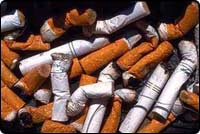March 14, 2005
Up In Secondhand Smoke: What Does Science Tell Us?
By Michael D. Shaw
[Introduction by Michael J. McCurdy, founder/publisher of HealthNewsDigest.com]
Few health issues are as controversial, emotional, and as subject to political correctness as environmental tobacco smoke (ETS) or passive smoking. So this week I invited Michael D. Shaw, an environmental scientist, to comment on the latest news released on Wednesday the 9th from the California Air Research Board, that second-hand smoke causes breast cancer in 20 – 90% of women and children. The American Cancer Society said that the study is “controversial.”
As a scientist who regularly writes about indoor air quality, I must approach this topic with an appropriate degree of objectivity: I do not have a vested interest in the politics of this matter, but I do have a responsibility – both as a biochemist and member of the scientific community – to dispel some commonly held myths about secondhand smoke and the risk of cancer.
Unfortunately, the entire subject of secondhand smoke resides in an area of discourse heavily laced with activists, who, passionate about their mission of improving public health, far too readily exaggerate the dangers. Moreover, the whole notion of ETS being listed as an indoor air pollutant started in the mid-1980’s, as hapless tenants in overpriced windowless high-rise office buildings sought creative means of breaking their leases. No doubt, workers could be irritated by ETS, but then, they could also be irritated by perfume. Indeed, excessive perfume is considered an indoor air pollutant in some quarters, along with cooking odors.
As to the matter of someone being “allergic” to ETS, based on the traditional definition of an allergen being an agent that promotes an immunological response, ETS fails that test, and so far, at least, can only be classified as an irritant. Properly, people are “sensitive” to ETS. But, playing on the well known dangers of smoking, the doom-profiteers have worked many people into a frenzy, by conflating the bad habit of smoking with the much different matter of breathing in secondhand smoke.
Science, at its best, should never have an agenda, and should aid the quest for truth. In the days before big media and big research grants, bizarre claims could be subjected to the harsh light of objective science. Nowadays, though, it is sometimes the alleged “science” that promotes the bizarre claims.
Back in the 1960’s, many health agencies proffered a set of two graphs. One tracked the increase in cigarette smoking from 1900-1930, and the other tracked the increased incidence in lung cancer from 1930-1960. That the two graphs could virtually be superimposed was as ringing an indictment of smoking as any gory autopsy picture of a smoker’s cancer-ravaged lungs. Contrast this with the paradoxical claim by the Centers for Disease Control a few years ago that passive smoking could explain an increase in asthma over the last decade, even though as asthma was increasing, the number of smokers was decreasing.
So, how dangerous IS secondhand smoke? The most reliable data would indicate that it is nowhere near as serious a threat as elements of the media (and their supporters within academia) would have us believe. In fact, ETS is, at its most extreme, far less dangerous than numerous other indoor air pollutants such as carbon monoxide, toxic mold, and radon.
The biggest study on this topic, covering 39 years, and involving 118,094 adults, with particular focus on 35,561 who never smoked, and had a spouse in the study with known smoking habits, came to this conclusion:
“The results do not support a causal relation between environmental tobacco smoke and tobacco related mortality, although they do not rule out a small effect. The association between exposure to environmental tobacco smoke and coronary heart disease and lung cancer may be considerably weaker than generally believed.”
Not surprisingly, considering the non-PC findings, the May, 2003 article detailing the study generated a good deal of hate e-mail on the journal’s website.
Several other studies support these results, including one from the prestigious New England Journal of Medicine, published back in 1975, when smoking was rampant in bars and other public places. The paper concluded that the concentration of ETS contaminants in these smoky confines was equal to the effects of smoking 0.004 cigarettes per hour. In other words, you would have to hang out for 250 hours to match the effects of smoking one cigarette.
But this issue is controversial, right? Just a few days ago, the trend-setting California Air Resources Board announced results of their draft report, “Proposed Identification of Environmental Tobacco Smoke as a Toxic Air Contaminant.” The report concludes that women exposed to secondhand tobacco smoke have a 90 percent higher risk of breast cancer. The document also pegs the annual death toll of secondhand smoke at 73,400.
It should be noted that the World Health Organization and other groups that examined the same evidence found no link to breast cancer. Furthermore, the Air Resources Board gives more weight to animal studies, but much epidemiology of suspected human carcinogens indicates that animal data overstates the actual risk.
My gut tells me that the Air Resources Board is wrong, but we’ll see how this all plays out.

